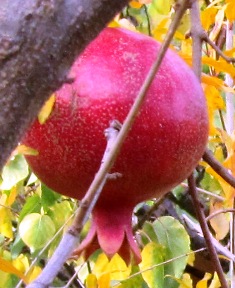Pomegranate: A Jewel of a Fruit with a Long History
This time of year, you’ll find plenty of pomegranates in the markets and on harvest festival tables. It’s an important fruit in Middle Eastern cuisine. In the fall, pomegranate plants produce garnet-colored fruit with a leathery rind.
The fruit ranges in size from that of a large apple to a small kumquat (for ornamental types of pomegranates). The pomegranate’s treasure, however, is hidden inside. There you’ll find bright red juice and glistening seeds that taste sweet or bittersweet and astringent.
The pomegranate was known to the ancient world. Long before the birth of Christianity, the Egyptians viewed the fruit as a symbol of prosperity. The Bible contains numerous references to the pomegranate and its symbolism as an image of fertility.
The fruit is indigenous to Persia (the area that includes the modern countries of Iran and Iraq). The pomegranate’s popularity has spread since ancient times throughout the Middle East, India, Asia, and elsewhere around the world.
Pomegranate has important uses in the ancient Indian Ayurevedic system of medicine, including as a counterbalance of diets high in sugar and fat. In Northern California’s east bay valleys, the plant is easily cultivated. Our neighbors to the left, right, and rear of our farmette all grow pomegranates.
There are many cultivars of the plant (bushes, trees, and ornamental varieties). Our trees are young and still pretty small. The branches are stiff and tend to arch. Small oval leaves create a delicate open pattern–almost a lacy look–in the garden.
The best method of propagation is through cuttings from wood that is at least a year old. The plants are excellent landscape choices. They are not too picky about soil and as they get older are somewhat drought tolerant. Grow in full sun and irrigate young plants. You[ll be rewarded with trees that remain relatively pest-free and bear plentiful fruit.
Ripe fruit still hanging on the tree can split open, revealing the seeds. But many who grow this fruit and appreciate its nutrient, antioxidant, and medicinal value seldom leave these gems on the tree to over-ripen and fall.
Tags: fertility, garnet, kumquat, Middle Eastern cuisine, Persia
 Facebook
Facebook Goodreads
Goodreads LinkedIn
LinkedIn Meera Lester
Meera Lester Twitter
Twitter






